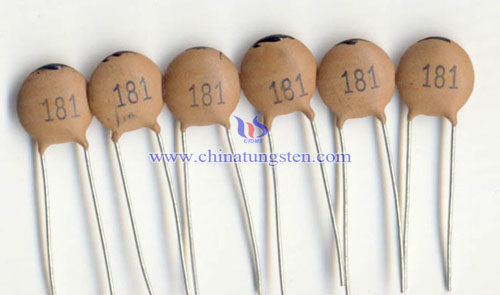Tungsten Bronze Application in Ceramic Capacitors
- Details
- Category: Tungsten Information
- Published on Wednesday, 25 May 2016 18:21
A ceramic capacitor is a fixed value capacitor in which ceramic material acts as the dielectric. It is constructed of two or more alternating layers of ceramic and a metal layer acting as the electrodes. The composition of the ceramic material defines the electrical behavior and therefore applications. Ceramic capacitors, especially the multilayer style (MLCC), are the most produced and used capacitors in electronic equipment that incorporate approximately one trillion (1012) pieces per year. Ceramic capacitors of special shapes and styles are used as capacitors for RFI/EMI suppression, as feed-through capacitors and in larger dimensions as power capacitors for transmitters. Ceramic capacitors are divided into two application classes: Class 1 ceramic capacitors offer high stability and low losses for resonant circuit applications. Class 2 ceramic capacitors offer high volumetric efficiency for buffer, by-pass, and coupling applications.
Temperature stability is of great importance for the preparation of multilayer ceramic capacitors in electronic products application. Two or more than two of the polyhydric compounds having opposite temperature coefficient and dielectric constant (τ ε) are mixed to produce a solid solution with small temperature coefficient and dielectric constant, this method is frequently used to realize the temperature stability of the materials; or, such as capacitor for BaTiO3, mixed dopant is dispersed in the ceramic body to produce ferroelectric - paraelectric phase transition near room temperature and the relatively stable material has been obtained. Currently, BaTiO3 compound fits X7R standard, its dielectric constant does not exceed ± 15% in the temperature range of -55 ℃ ~125 ℃ compared to the change rate of dielectric constant at room temperature, the dielectric loss tan σ is less than 0.02 at 1MHz. However, if PbTiO3 (Tc = 4950C) is not doped, the maximum operating temperature does not exceed 130 ℃.
Miniaturized drives and speed of the computer transfer more focus into the high-temperature resistant parts, the capacitor must be able to work at 150℃ or even 200℃ in the future. However, the application of PbTiO3-BaTiO3 composite multilayer ceramic capacitor is not desirable, the first reason is 1¾ toxicity, the second one is that easy to decompose in low oxygen partial pressure, and Ni metal electrode will form into low melting point alloy with it. The same problem also appears in BiTiO3 doped by Bi2O3 base solid solution. The ideal new materials require the phase transition temperature is between -50 ℃ ~250 ℃, without PbO or Bi2O3 , containing relatively common and inexpensive raw materials.
Recently, domestic and foreign researchers found that a number of Tantalates with tungsten bronze structure having high dielectric constant (> 100) and low dielectric loss, is expected to be the dielectric materials with temperature stability being used in multilayer ceramic capacitors. The ceramic dielectric constant ε r is between 127~175, dielectric loss tan σ is less than 0.009 at 1MHz, the dielectric constant and temperature coefficient τ ε is between -7¾~-2500ppm / ℃. But the dielectric constant and temperature coefficient of these tantalates with tungsten bronze structure are too large, the dielectric constant is too low, thus the practical applications are limited.


| Tungsten Oxide Supplier: Chinatungsten Online www.tungsten-oxide.com | Tel.: 86 592 5129696; Fax: 86 592 5129797;Email:sales@chinatungsten.com |
| Tungsten News & Prices, 3G Version: http://3g.chinatungsten.com | Molybdenum News & Molybdenum Price: http://news.molybdenum.com.cn |